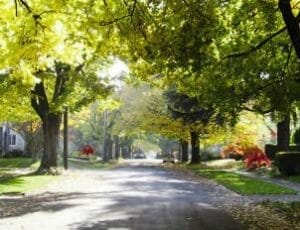
Any homeowner who has gotten a notice from the City of Portland to repair their sidewalks, or else, knows how contentious of a battle it can be for trees and sidewalks to co-exist in the city. Tree roots lifting the concrete slabs can be a major headache. Not only are the quotes from concrete contractors enough to make you sick the thought that due to your tree’s roots you may have to do this again in a few years is just about enough to drive you over the edge. I wish I had some miracle cure-all solution to ease the pain, but unfortunately, when it comes to controlling tree roots and repairing sidewalks that have been raised by tree roots there is only so much that can be done.
What Not To Do When Dealing With Tree Roots Lifting A Sidewalk
- Do Not cut a tree root yourself or let your concrete contractor cut one. Tree roots that are causing damage to a sidewalk and need to be cut must be marked by the city arborist prior to cutting. Cutting them without this approval is a surefire way to cause permanent damage or death to your street trees and to buy yourself a hefty fine from the city. This includes the method of carving an “X” on the top of the tree root (which does not work, by the way). Studies show that despite tree root pruning, sidewalks will, on average, lift again within five years without the use of other root control methods.
- Do Not heavily prune your tree or use tree growth inhibitors. Heavy pruning is expensive and most of the time does not work to keep tree roots from damaging sidewalks. When tree growth inhibitors are used energy that would normally go to the development of the crown of the tree is often redirected to the root system, actually further aggravating the problem.
- Do Not assume you need to replace your concrete. Concrete contractors have other options and if you are going to end up repairing your sidewalk due to root growth again in a few years you may want to hold off if there are other options available to you such as concrete grinding and/or patching. Contact our office about sidewalk repair options that we offer at Urban Forest Professionals.
- Do Not wait! If you get a notice from the city it usually gives you an extended amount of time to correct the problem. They do that for a reason because it takes an extended amount of time to arrange all the permitting and the work to get done.

How To Prevent Tree Roots From Lifting The Concrete Slabs of A Sidewalk
As with many things the solution starts with prevention. The type of tree planted is a big determiner if you are going to have root problems with your sidewalk in the future. As is if the tree is planted correctly. You can review our blogs posts under tree planting for advice on choosing and installing a tree correctly to avoid damaging your sidewalk in the future. Additional options such as root barriers or establishing a tree protection area can be installed when trees are young to direct the growth of roots. Sometimes it is better to remove existing trees, start over, and get it right the second time. Of course, you will need the city arborist’s blessing to do this.
How To Repair Sidewalks Damaged By Tree Roots
Nothing will determine your success in dealing with the invasion of growing roots in your sidewalk more than choosing the right concrete contractor when repairing or replacing your concrete. You need a contractor who is willing to use a complete arsenal of tactics to repair the current problem and prevent a re-occurrence. These methods include but are not limited to the use of pea gravel which allows tree root to expand, reinforcing concrete with rebar so that the tree root must lift several slabs at once in order to cause damage to the sidewalk, creating a meandering sidewalk or a sidewalk with cutouts to create more space for roots, and create slightly sloping sidewalks to allow elevation change due to root growth. Homeowners should also explore the option of having the sidewalk repaired or ground down instead of removed and replaced to limit their investment. A knowledgeable concrete contractor will explore all of these options with you including repair.
Another option for a long-term solution for repairing sidewalks or curbs that are lifting due to tree roots is rubber sidewalks. Here at Urban Forest Pro we are proud to be one of only a few in the Portland, OR area to offer rubber sidewalk services. These sidewalks are just as sturdy as traditional concrete but are more flexible, reducing the risk of cracking in the long run.
Contact Urban Forest Professionals When You Need Your Sidewalk Repaired Due To Tree Root Growth
If your tree roots are lifting the concrete slabs of the sidewalk outside of your home and causing damage feel free to contact us for a consultation. We offer concrete repair options and tree root pruning services, and because we are experienced arborists we can determine the best course of action to not only repair the sidewalk but deal with the tree and roots that are causing the issue, hopefully keeping you from having to deal with tree root sidewalk repairs for years to come. Call our office today for your free estimate. 503-912-8092
We serve not only the Portland area but also: Gresham, Beaverton, Tigard, and more.

What Our Clients Say About Us
“This was the nicest experience. They removed a tree from our front yard and had to return for a second overgrown root that was huge, which they did with no question. They left the place looking great. They were professional and pleasant from the beginning to the end, and even sent a thank you card which I thought was very cool. They are five stars all the way.”
Robin W.
Rating: 5/5 ⭐⭐⭐⭐⭐
And read more of our 194+ reviews on Google.
We Also Offer: Tree Removal, Stump Grinding Services, Pruning, and more.
This post first appeared on https://www.urbanforestprofessionals.com